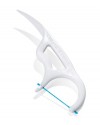

 Swiss premium oral care
Swiss premium oral care
 United Arab Emirates
United Arab Emirates

Dental floss and toothpick in one
Dental floss and toothpick in one

Floss and toothpick combo

Reaches difficult areas

Disposable and travel-friendly

Floss and toothpick combo

Reaches difficult areas

Disposable and travel-friendly
DF flosspic is particularly easy to use – and ideal when travelling. Ergonomically designed. 30 pcs
Ergonomically designed, Curaprox flosspic supports oral hygiene, thereby preventing tooth decay and gum disease.
 Swiss premium oral care
Swiss premium oral care